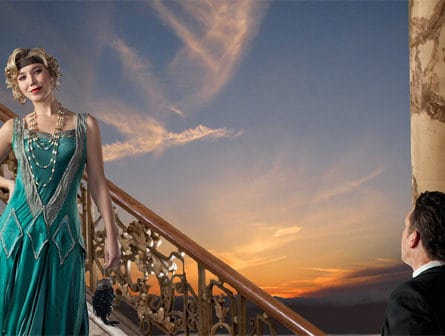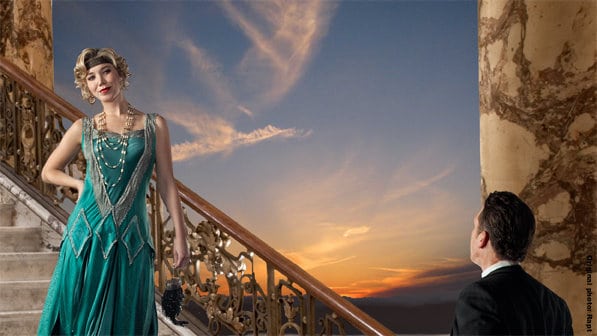 As the audience gathered in the Yerba Buena Center for the Performing Arts, they were faced with a 1920’s sofa flanked by two armchairs, with a bar off to the side. Partially obscured by an ethereal scrim, it suggested more would be revealed. Once the audience hit some critical mass, a projection of a projection displaying an aged advertisement for an oculist, through which a pair of eyes looked back at the audience. Mesmerizing, the unrelenting gaze of eyes took in everything and remained riveted upon the audience.
As the audience gathered in the Yerba Buena Center for the Performing Arts, they were faced with a 1920’s sofa flanked by two armchairs, with a bar off to the side. Partially obscured by an ethereal scrim, it suggested more would be revealed. Once the audience hit some critical mass, a projection of a projection displaying an aged advertisement for an oculist, through which a pair of eyes looked back at the audience. Mesmerizing, the unrelenting gaze of eyes took in everything and remained riveted upon the audience.
Thus began The Great Gatsby, an ambitious undertaking by Ensemble Parallele. Expectations were impossibly high for this work, as it followed last year’s Orfeo which was both critically and popularly well received. Parallele Ensemble is a contemporary chamber orchestra, led by musical director Nicole Paiement. This work, originally authored by John Harbison, was commissioned to commemorate the 25th anniversary of James Levine’s debut. Originally performed in 1999, it has only been performed on three other occasions. This re-orchestrated version reduces the orchestra to a mere 30 musicians, from the original 80.
Exquisite costumes, imaginative lighting, and video artistry evidence the incredible work poured into this production. Particularly compelling were the set designs, which were dominated by architectural components. These came and went, but remained flanked by two columns positioned at the far sides of the stage, which once again subtly picked upon on the theme of duplication: projections about projections, and architectural components used to frame other architectural components. Echoes of “the green light,” a phrase adapted from the last page of The Great Gatsby, occurred throughout the production in both costume and lighting design.
More Stark Insider
Initially, my curiosity was piqued as to how a book that relied so heavily upon an astute and canny narrator could be conveyed on stage. Since this seemed so impossible, I was not surprised that program notes reminded the reader that the opera differs from the novel because “opera is a medium that mythologizes and in many ways exaggerates.” While much of the languorously insipid dialogue in the novel makes it to the stage virtually intact, few of Nick Carraway’s astute observations make the same traversal, which creates an odd imbalance as much of the mythologizing referenced in the notes doesn’t become obvious until the latter scenes of the second act. This imbalance isn’t as weighty as it might be because dialogue is broken up by exquisite orchestral passages between key scenes. If I was to see this a second time, I would pay far more attention to the colorful orchestration. Likewise, the banality of dialogue is also broken up by intensely engaging scenes of a black-and-white ball. Featuring an on-stage band and 1920’s dance numbers, the action rivaled that of any large musical scene.
Soprano Susannah Biller captured all attractions of Daisy, making her a sympathetic character. Biller’s lush voice had both power and expressivity, with a tendency to linger delightfully on the ends of her lines. Tenor Marco Panuccio’s performance was mixed as he seemed to be straining at times in the first act, most noticeably at louder volumes. However, he positively shone in the quieter numbers of the second act that highlighted the expressivity of his voice.
The Great Gatsby
3.5 out of 5 stars (Sweet Stuff)
Novellus Theatre, Yerba Buena Center for the Arts
Nicole Paiement: Conductor
Brian Staufenbiel: Director
Libretto & Score: John Harbison
Re-orchestration: Jacques Desjardins
Daisy: Susannah Biller (Soprano)
Nick Carraway: Jason Detwiler (Baritone)
Jay Gatsby: Marco Panuccio (Tenor)
Tom Buchanan: Daniel Snyder: (Tenor)
By Ensemble Parallele
Performance attended: February 11, 2012
www.ensembleparallele.com



